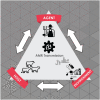Lessons from Dairy Farmers for Occupational Allergy and Respiratory Disease
- PMID: 37191901
- PMCID: PMC10186320
- DOI: 10.1007/s11882-023-01081-2
Lessons from Dairy Farmers for Occupational Allergy and Respiratory Disease
Abstract
Purpose of review: Exposure to bioaerosols at dairies has long been associated with allergy, respiratory disease, and decreases in lung function. Recent advancements in exposure assessments have aided our understanding on the size distribution and composition of these bioaerosols, but investigations focusing solely on exposures may overlook important intrinsic factors impacting worker's susceptibility to disease.
Recent findings: In our review, we discuss the most recent studies examining the exposures and genetic factors that contribute to occupational disease in dairy work. We also review more recent concerns in livestock work associated with zoonotic pathogens, antimicrobial resistant genes, and the role of the human microbiome. The studies highlighted in this review demonstrate the need for further research to better understand bioaerosol exposure-response relationships in the context of extrinsic and intrinsic factors, antibiotic-resistant genes, viral pathogens, and the human microbiome to help inform effective interventions that improve respiratory health among dairy farmers.
Keywords: Antibiotic resistance; Dairy workers, Bioaerosol exposures; Influenza; Microbiome; Respiratory health.
© 2023. The Author(s), under exclusive licence to Springer Science+Business Media, LLC, part of Springer Nature.
Conflict of interest statement
None declared.
Figures


References
Publication types
MeSH terms
Grants and funding
LinkOut - more resources
Full Text Sources
Medical
Research Materials

